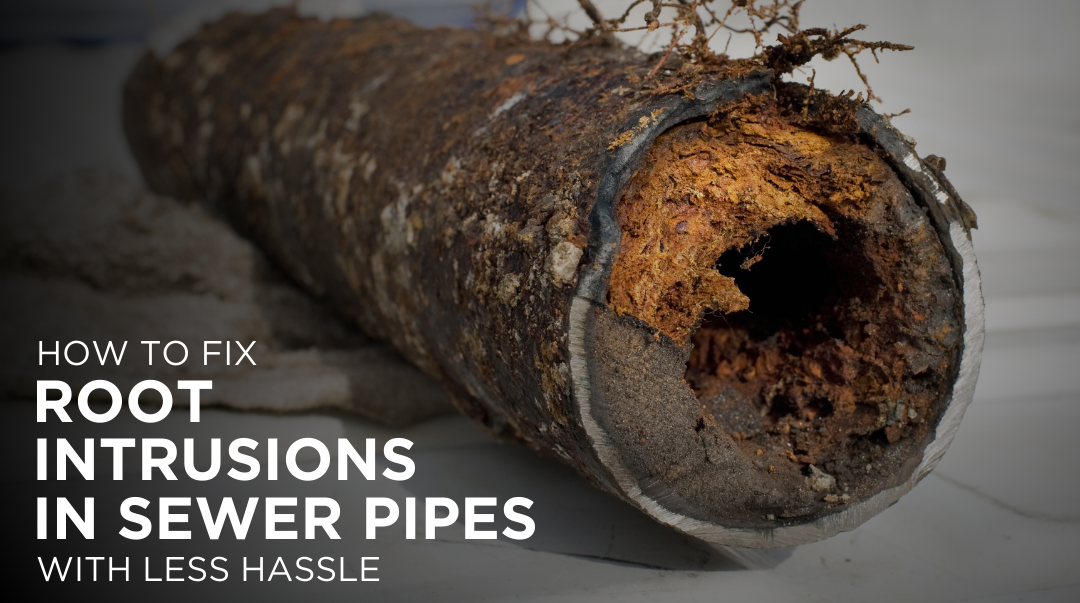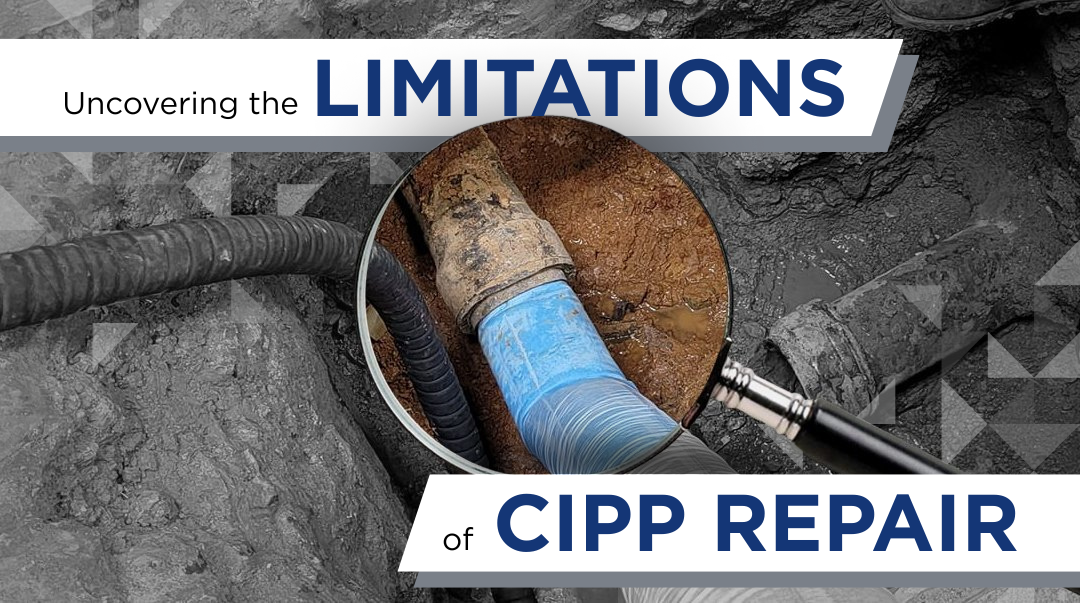Fixing Root Intrusions in Sewer Pipes: 4 Reasons You Should Be Using CIPP
Trees and bushes are serious about finding water sources. And that raw determination can cause substantial damage to anything in their path, including sewer lines. Homeowners who have experienced root intrusions know how serious that damage can be, and they know that fixing it can be expensive, time-consuming, and frustrating.
So how should pipe repair businesses fix root intrusions in sewer pipes with as little disruption as possible, and with a less shocking repair bill? With all the methods drain cleaning and repair companies have to choose from, the option that covers the most needs is CIPP repair. With its fast, noninvasive process, fixing root intrusions is simple and effective for decades.
Key Takeaways
Temporary fixes for root intrusions can be less expensive, but often result in having to deal with more intrusions later on.
Some permanent options are viable for long-term solutions, but can damage property or extend downtime for homeowners.
CIPP repairs reduce downtime, maintain property, and provide root intrusion elimination for 50+ years in many cases.
Pipe repair companies with a pipe lining supply partner like T3 can reduce expense, streamline efficiency, and provide consistent training for every member of their teams.
Why Is It Important to Fix Root Intrusions in Sewer Pipes?
Root intrusions in sewer pipes can cause many problems, both minor and major, for homeowners and their property. It’s especially common for sewer lines made of terra cotta or clay, but root intrusions can also occur with rusted cast iron sewer pipes and damaged PVC lines.
When plant roots break into sewer lines, the wastewater inside can leak into the ground around it. Early on, that leaking can contaminate the soil and cause environmental issues. But if it isn’t repaired quickly, root intrusion can lead to soft, muddy soil along and around the sewer line. That wastewater can also cause foul smells and damage to concrete, landscaping, and hardscaping. Homeowners in need of sewer pipe repairs want a fast and effective solution to keep their property safe.
How to Fix Root Intrusions in Sewer Pipes
Root intrusions in sewer pipes is especially common for sewer lines made of terra cotta or clay, but root intrusions can also occur with rusted cast iron sewer pipes and damaged PVC lines.
When plant roots break into sewer lines, the wastewater inside can leak into the ground around it. Early on, that leaking can contaminate the soil and cause environmental issues. But if it isn’t repaired quickly, root intrusion can lead to soft, muddy soil along and around the sewer line.
That wastewater can also cause foul smells and damage to concrete, landscaping, and hardscaping. Homeowners in need of sewer pipe repairs want a fast and effective solution to keep their property safe.
Temporary Solutions for Root Intrusions
Homeowners are often looking for inexpensive or do-it-yourself alternatives to calling a plumbing or pipe repair company. Some temporary solutions could save some money upfront, although a professional may still be required for more severe issues.
Methods
Chemical Removal: The most common temporary solutions to root intrusion issues generally employ chemicals to kill and dissolve the roots in the sewer pipe. These root-killing chemicals can include rock salt, foaming root killers, and copper sulfate.
Mechanical Removal: It’s also possible to remove tree roots mechanically. Water jets and cutting heads can eliminate existing obstructions quickly, and in most cases, they’re safe for pipes.
Pros
These cleaning methods usually offer homeowners low-cost solutions to root intrusions, so long as the pipes are structurally sound. And the use of chemical root killers can be a DIY option so a homeowner can address the problem without a contractor.
Cons
While temporary solutions can offer a simple and cost-effective alternative to major repairs, both mechanical and chemical removal of the roots will need to be repeated regularly (likely once a year or so). These options simply don’t address the primary cause of the sewer line damage. And when you remove tree roots in sewer pipes with chemicals, the process is often a guessing game as to how effective it will be long-term
Permanent Solutions for Root Intrusions
On the other hand, homeowners may want (or need) a more permanent solution to their root intrusion woes. These longer-lasting methods allow homeowners to fix root intrusions in sewer pipes only once, rather than once a year.
Methods
Permanent sewer lateral root removal options like pipe bursting, slip lining, and even full trenching and replacement aim at solving the problem at the source: the roots. In each case, the host pipe isn’t just cleaned out. Instead, it’s either reinforced or replaced.
Along with addressing the intrusions in the pipe, it may be necessary to remove the plants that caused the root intrusions. This removal better ensures that the sewer pipe won’t be damaged again.
Pros
The most important advantage of choosing a permanent fix for root intrusions is that it will only need to be performed once. In many cases, the repair could last as long as 50 years.
Cons
These permanent solutions are often more expensive than temporary fixes like root killers or drain cleaning. But they can also cause damage to landscaping and concrete above and adjacent to the sewer line. Pipe bursting can also compromise grade, which could cause damage to larger structures like patios.
Root Intrusion Methods Compared: Temporary vs. Permanent Options
| Root Intrusion Repair Method | Type of Method | Pros | Cons |
|---|---|---|---|
| Chemical Removal | Temporary | Inexpensive DIY-friendly Works for minimal intrusion issues |
Inconsistent results Must be repeated annually or more |
| Mechanical Removal | Temporary | Chemical-free More consistent results |
Requires contractor Must be repeated annually or more May compromise structural integrity of pipe |
| Slip Lining | Permanent | Eliminates future root intrusions Provides structural stability for pipe |
Requires digging for access Limited applications Reduces flow capacity in smaller pipes |
| Pipe Bursting | Permanent | Completely replaces damaged pipes when trenching is not possible or desired Provides a long-lasting solution |
Requires large footprint for accessing and installation Can cause issues with grade above the repair |
| Open Trenching and Replacement | Permanent | Complete access to broken pipes No limitations for pipe condition |
Expensive due to rehab costs Disrupts yards, concrete, and structural elements to access pipes Repairs can take weeks to complete |
| CIPP Repair | Permanent | Noninvasive, with almost no digging required Repairs can be completed in as little as 3 hours No disruption to landscaping or structural elements Less expensive than trenching More effective than temporary solutions |
Some pipe conditions aren’t repairable (bellying, pipe collapse, diameters ≤ 2”) Serious structural damage will limit effectiveness of new liner |
Why Use CIPP Lining to Fix Root Intrusions in Sewer Pipes?
There is a solution that offers both a fast and effective way to fix root intrusions in sewer pipes: CIPP lining. This trenchless repair method offers long-term benefits without the drawbacks of other temporary or permanent solutions. Plus, there are few exceptions to what can be repaired.
What Is CIPP Lining?
Cured-in-Place Pipe (CIPP) lining is a pipe repair technique where a felt or fiberglass liner is inserted into a damaged host pipe and then cured inside the pipe using heat, steam, or UV light. Most repairs take less than 4 hours to complete, and CIPP provides a completely new and structurally functional “pipe within a pipe” without digging and trenching.
Benefits
Cost-Effective: CIPP is less expensive than trenching, and the one-time repair eliminates years of expense for DIY and temporary fixes.
Less Damage: With little to no digging, lawns, sidewalks, and driveways stay intact.
Fast Repairs: Today’s CIPP technology can cut repair timeframes down to hours instead of days or weeks.
Long-Lasting: The cured epoxy resin is as hard as PVC pipe, so it keeps tree roots from breaking into the sewer line in the future. And CIPP repairs can last 50 years or more.
Reliable: CCTV inspections before and after CIPP installations make it possible to be confident that sewer lines are repaired correctly, making it a more reliable option for both homeowners and pipe repair businesses.
Exceptions
Bellies: If the pipe has a belly, CIPP liners can’t bond properly to the walls.
Collapses: Pipe liners need to be pushed through the pipe lines, so if a pipe has collapsed underground, you’ll need a different approach.
Serious Structural Damage: Pipes must be strong enough to handle the pressure of the liner during the curing process without bursting.
Shifting: In seismically active areas, a visual inspection could show that clay pipe sections have pulled apart. In some cases, CIPP may still work, but in most cases, these shifts make it difficult for the liner to be inserted properly.
The Right Pipe Lining Supply Company Makes a Difference
If you run into sewer line repairs and replacements on a regular basis, it’s worth your time and effort to find a pipe lining supply company that can help you cut down on the number of trench repairs you do each year. You’ll be able to save time, money, and labor with CIPP in your toolbox.
But you need to choose a company that works for your business.
At T3, we’re here to make it easier for small businesses to start offering CIPP lining services to their customers. We work directly with you and your teams to learn all the techniques you’ll need to confidently tackle any pipe lining repair problem you encounter. Our expert training team and 24-hour customer service help you get up and running quickly and keep your business going when you need it the most.
Ready to offer quality sewer pipe repairs without the hassle of digging? Reach out today to see how T3 Lining Supply can make it possible!






